
La Recoleta Cemetery is a cemetery located in the Recoleta neighbourhood of Buenos Aires, Argentina. It contains the graves of notable people, including Eva Perón, presidents of Argentina, Nobel Prize winners, the founder of the Argentine Navy, and military commanders such as Julio Argentino Roca. In 2011, the BBC hailed it as one of the world's best cemeteries, and in 2013, CNN listed it among the 10 most beautiful cemeteries in the world.

Florida Street is a popular shopping street in Downtown Buenos Aires, Argentina. A pedestrian street since 1971, some stretches have been pedestrianized since 1913.
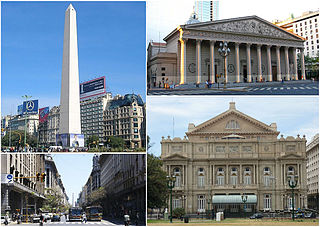
San Nicolás is one of the neighbourhoods of Buenos Aires, Argentina, sharing most of the city and national government Neighborhood of Buenos Aires with neighboring Montserrat and home to much of the financial sector. It is referred usually as El Centro, and the part east of the 9 de Julio Avenue is known as Microcentro.

Retiro is a barrio or neighborhood in Buenos Aires, Argentina. Located in the northeast end of the city, Retiro is bordered on the south by the Puerto Madero and San Nicolás, and on the west by the Recoleta.

Banco de la Nación Argentina is a national bank in Argentina, and the largest in the country's banking sector.
The Olimpia Awards are Argentine sports awards given annually by the Círculo de Periodistas Deportivos since 1954. An Olimpia de Plata is awarded to the outstanding performer in 41 sports.

According to the World Travel & Tourism Council (WTTC) the travel and tourism sector of Argentina was moving towards recovering its pre-covid pandemic contribution to GDP in mid-2023, led by Buenos Aires.

The Parque de la Ciudad is a former amusement park in the Villa Soldati neighborhood of Buenos Aires, Argentina.

The Palacio Duhau - Park Hyatt Buenos Aires is a five star hotel located in the city's Recoleta section. Originally opened in 1934, the palace has been operated by multinational hospitality company Hyatt since 2006. The palace was declared national historic landmark in 2002.

Harrods Buenos Aires was a department store based in Buenos Aires, Argentina based on the corner of Córdoba Avenue and San Martin. The store was a branch of the famous Harrods of London which was opened in 1849. The store opened in 1914 and closed in 1998, since closure there has been numerous attempts to reopen the store.

Catalinas Norte is an important business complex composed of nineteen commercial office buildings and occupied by many leading Argentine companies, foreign subsidiaries, diplomatic offices, and a hotel. It is located in the Retiro and San Nicolás neighborhoods of Buenos Aires, Argentina.
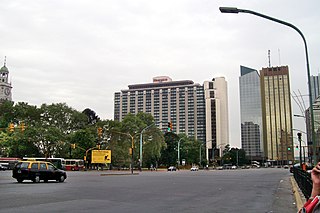
The Sheraton Buenos Aires Hotel & Convention Center is a five-star hotel located in the District of Retiro, Buenos Aires, Argentina.

The Ministry of Public Works Building, now known as the Ministry of Health Building is a public building in the rationalist style located on the intersection of 9 de Julio Avenue and Belgrano Avenue, in the neighborhood of Monserrat, in Buenos Aires, Argentina. It is currently used by the Ministry of Health of Argentina.
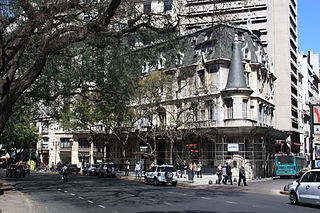
The Palacio Haedo is a 19th-century building on the Avenida Santa Fe in Buenos Aires, Argentina. It is located to the south of the Torre de Los Ingleses and the Plaza San Martín and Monument del libertador Jose de Plaza San Martín, in close proximity to the Consulate of Colombia and the Gran Hotel Buenos Aires. It was built in the late 19th century as a residence for the Haedo family by architects Passeroni and Brizuela in the Neo-Gothic style.

Joaquín Canaveris was an Argentine attorney, merchant, politician and military man, who served as consignee in The Consulate of Buenos Aires. He had an active participation in the defense of Buenos Aires during the English invasions, serving as an Assistant in the battalion of Tercio de Vizcaínos.
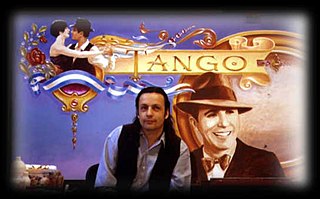
Jorge Muscia is a plastic artist and ‘fileteado’ instructor with over 30 years of experience in his field. Muscia, also known as the Fileteador of Tango, distinguishes himself for being a force in the revival of this old style of painting and for being a renowned instructor and promoter of the art of the filete in Argentina and the world.
Juan Manuel Canaveris (1804-1868) was an Argentine jurist and politician, who served in Buenos Aires and Montevideo as attorney, teacher and military man. He participated of the escort of honor in the funerals of Manuel Dorrego, and collaborated in the early days of government of Juan Manuel de Rosas.
Fonda de los Tres Reyes was an Inn or Tavern that worked in Buenos Aires in the late 18th century and early 19th. It was the main hotel and restaurant in the city, located in the neighborhood of San Nicolás, populated around 1810 by a considerable number of British and American immigrants.

Adrián Emmanuel Martínez is an Argentine footballer who plays as a forward for Instituto.
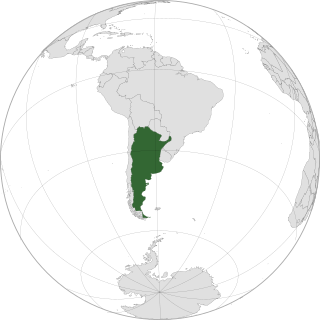
Squatting in Argentina is the occupation of derelict buildings or unused land without the permission of the owner. Shanty towns emerged on the periphery of Buenos Aires from the 1930s onwards and are known as villa miseria. After the 1998–2002 Argentine great depression, 311 worker cooperatives set up across the country as people squatted and re-opened businesses.

















